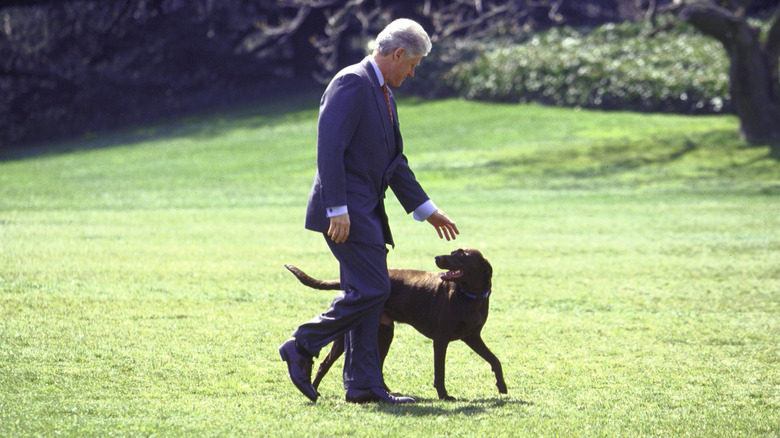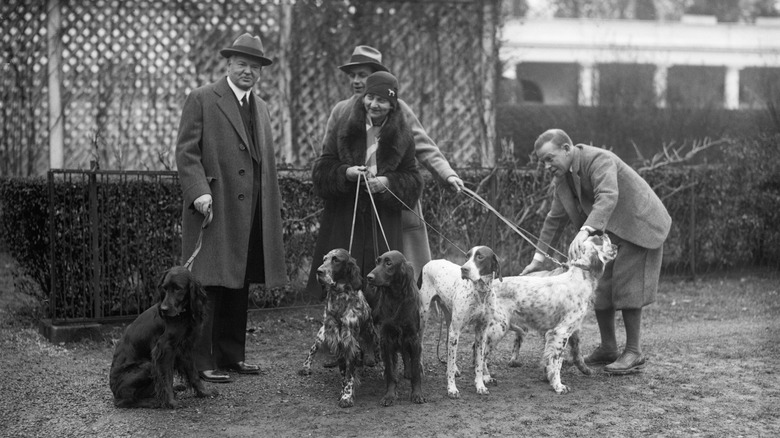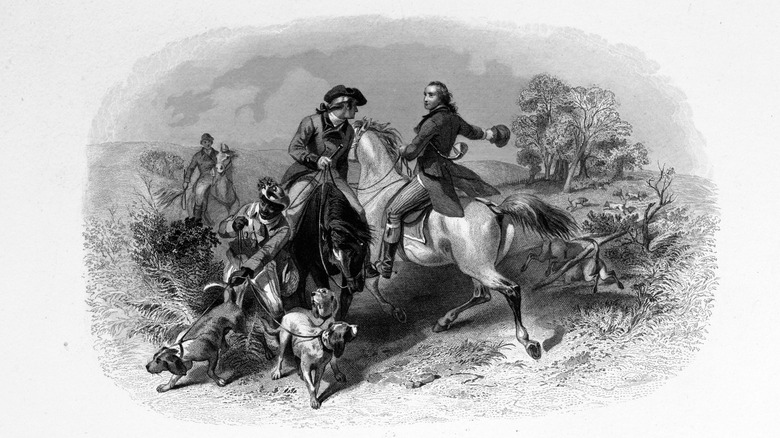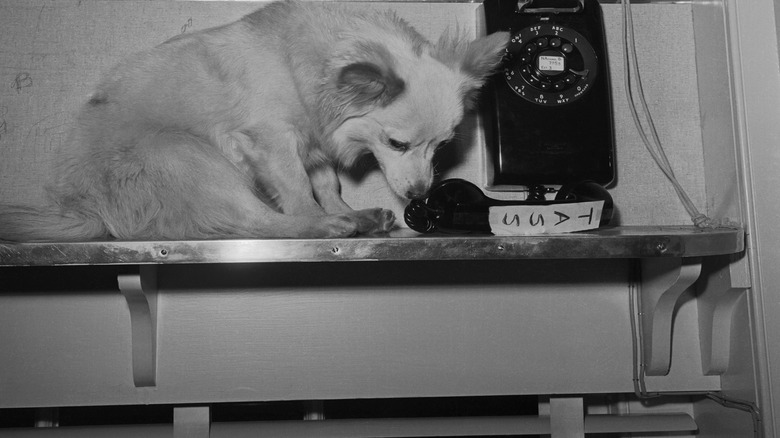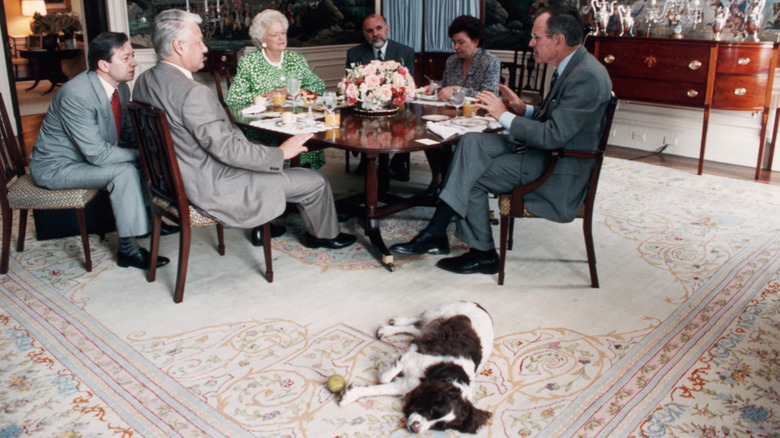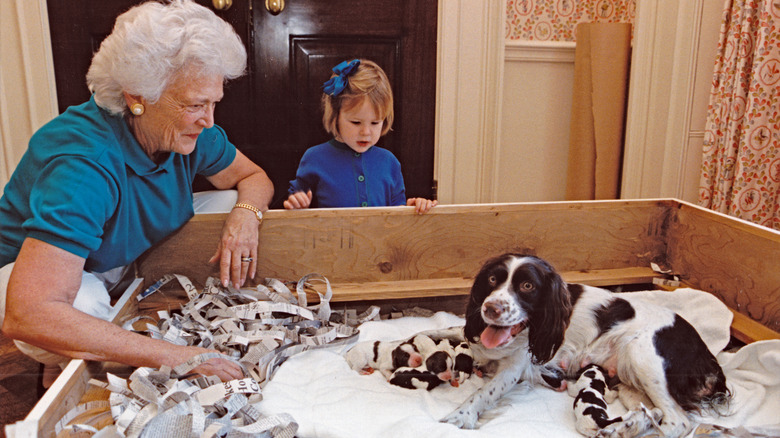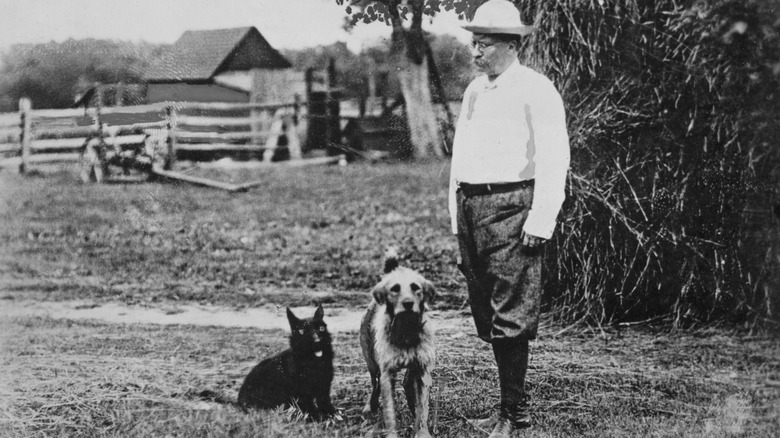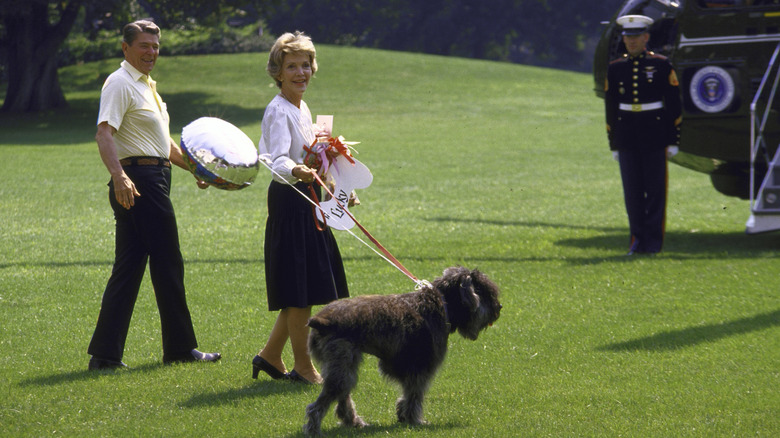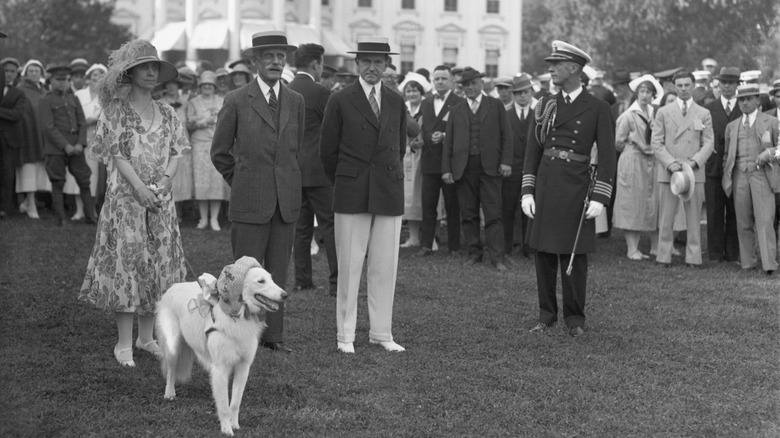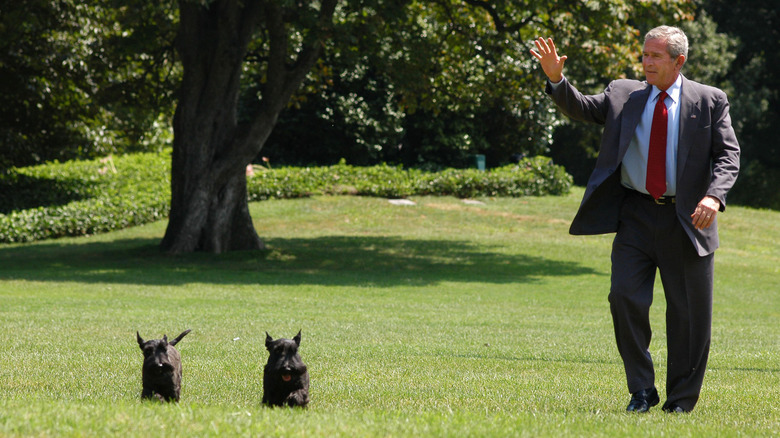The Former First Dogs Of The White House: What You Never Knew
The general public may not get much insight into the personal lives of U.S. presidents, but one thing is clear: they love their dogs. Over 100 canine occupants have called the White House home since the country's founding, outnumbering their presidential counterparts by more than two to one. As diverse as the nation itself, they've come in all breeds, colors, and sizes.
While dogs are the most popular animal owned by former presidents, dozens of different species have been brought to live on the White House grounds. In addition to common house pets like cats and birds, these include bears, badgers, flying squirrels, raccoons, and an alligator. Martin Van Buren, the eighth president, even wanted to keep a pair of tigers; to his disappointment, Congress denied the request. Only three presidents -– Van Buren, James K. Polk, and Donald Trump –- have not brought any pets into the executive mansion during their terms.
Although first dogs don't earn an official title or collect a salary, these loyal companions have been present for some of the most pivotal moments in United States history. Some have even played memorable roles in politics, culture, and international affairs. At many times, Americans have become so enamored with presidential pets that they've earned celebrity status in their own right.
The record for the most first dogs is 15
Some presidents have chosen to only invite one or two pets into the White House, but others have opened their new home to a whole pack of four-legged companions. President Herbert Hoover was no exception. The 31st president called an astounding 15 dogs family, setting the record for most first dogs kept at 1600 Pennsylvania Avenue by a single U.S. president.
President Hoover's canine roster included Irish wolfhounds, Belgian Malinois, and Norwegian elkhounds, among others. He also had an opossum, a cat, and a bird while residing in the White House. A letter he wrote to a friend more than a decade before taking office demonstrates how he viewed his household pets as genuine family members: "We have in our family 2 small boys, 1 dog, 2 cats, 11 goldfish, 1 canary, 3 frogs, 14 chickens, 2 turtles, 1 rabbit."
Most of Hoover's pets were gifts from friends and political connections, such as Buckeye, a Belgian Malinois given by an Ohio politician's family. In turn, many went on to find forever homes with White House staffers and soldiers after their time at the White House had ended. President Hoover seemed to have an affinity for the Irish dog name Cragwood, giving the title to three Irish wolfhounds, all of whom were gifted by a childhood friend. Their names were Cragwood Padraic, Cragwood Padraic II, and Cragwood Seamrog.
George Washington had a reputation for giving his dogs creative names
President George Washington's numerous dogs, most of which were various hounds who assisted him during long hunts, bore names like Drunkard, Sweet Lips, and Madam Moose. They lived alongside eight horses, all of whom were given comparatively mainstream names such as Samson and Magnolia. None of Washington's dogs ever lived in the White House, as the grand mansion that now houses each first family was not fully constructed until 1800. Instead, the president's canines all lived out their days running through the fields of his estate at Mount Vernon in Virginia, about 15 miles south of the District of Columbia.
Despite his collection of peculiarly named pups, Washington wasn't the only president to follow this trend. Many others chose names for their dogs that might raise an eyebrow. Calvin Coolidge, for example, had a Boston bulldog he named Beans. Herbert Hoover's Norwegian elkhound, originally named Norway, eventually came to be called Weegie after his granddaughter coined the nickname. Satan, the name John Adams chose for his dog, alludes to just how rambunctious the pup was known to be.
The first American foxhounds were presidential pets
When George Washington wasn't busy serving as the country's first president, he spent his free time pursuing a hobby as an avid fox hunter. At the time, fox hunting was a popular sport among young men in the United Kingdom that had slowly made its way to the newly established United States. Standard practice for the sport was to train groups of English foxhounds to sniff out burrowing foxes so that the men who followed on horseback could hunt them.
President Washington saw an opportunity to create an even better breed for fox hunting. He began crossing various English and French hounds in an effort to find a lighter, speedier, and more independent companion for his hunting trips, eventually breeding the first American foxhounds. Washington is now recognized by the American Kennel Club as the breed's creator.
Today, American foxhounds are considered an ideal family dog for households with young kids and multiple pets. They need plenty of exercise and have a tendency to express themselves by vocalizing, just as they were bred to notify their human companions of nearby foxes. In Washington's honor, American foxhounds were made the official state dog of Virginia in 1966.
One first dog was accused of espionage
It's not unheard of for presidential pets to make headlines, and John F. Kennedy's dog, Pushinka, is a notable example. President Kennedy was gifted the small mixed breed dog by then-Soviet leader Nikita Khrushchev in 1961, a tense year for relations between the two men's respective countries due to the Cold War. Pushinka's mother, Strelka, had recently become one of the first dogs to make a successful round-trip voyage into outer space.
What began as a gesture made in good faith soon escalated into a national security matter. CIA officials, suspicious that Pushinka could potentially be a living Trojan horse carrying a hidden microphone or deadly weapon, immediately brought the pup to Walter Reed Army Medical Center for a thorough examination. Thankfully, Pushinka was determined to be nothing more than a lovable companion for President Kennedy and his family, and she was soon accepted into the fold. Pushinka eventually had puppies of her own with another of the family's dogs, Charlie.
A Reagan family dog lived out retirement in a mini White House
Rex, a Cavalier King Charles spaniel and one of two first dogs that belonged to the Reagan family, was a fixture in the White House during his presidential counterpart's time in office. Named after a White House staffer with the same first name, Rex could frequently be spotted accompanying President Ronald Reagan and First Lady Nancy Reagan on official business. While Rex's adopted canine sister, Lucky, was ultimately sent to live in California before the end of Reagan's term due to her size, Rex remained in Washington with the first family until their departure in 1989.
Upon leaving the presidency, Ronald Reagan was gifted a doghouse in the form of a miniature White House for Rex to enjoy in his California retirement home. The doghouse was fitted with carpeting from Camp David so that Rex would "feel right at home", according to Ken Duberstein, Reagan's chief of staff who presented the family with the custom-made gift (via Ronald Reagan Presidential Library). "Now there will always be a Rex in the White House," Duberstein remarked.
Millie, a springer spaniel belonging to George H.W. Bush, was a bestselling 'author'
Among the most accomplished pups to ever inhabit the White House was Millie, a springer spaniel and one of two first dogs during the George H.W. Bush administration. Millie rose to the spotlight in 1990 after she "co-authored" a book with First Lady Barbara Bush. The autobiography, titled "Millie's Book", offered a lighthearted depiction of Millie's daily life as a first dog, from attending meetings in the Oval Office to chasing squirrels across the White House lawn.
"Millie's Book" earned $1.3 million in sales within less than two years, some of the proceeds of which were donated to the Barbara Bush Literacy Foundation. The organization funds adult and family literacy programs across the United States, providing mentorships, education, and access to reading materials. Barbara created the nonprofit during her tenure as first lady; it continues to operate decades later with the involvement of her daughter. Millie died suddenly at the age of 12 in 1997.
A mother and daughter were first dogs during different presidencies
Millie may have formally entered the public eye as the co-author of her autobiography, but in 1989, a year prior to the book's publication, she made headlines by giving birth to a litter of puppies at the White House. First Lady Barbara Bush was photographed multiple times showing off the puppies to heads of state, including the king of Jordan, who visited the White House during this period.
Spot, one of the puppies from Millie's litter born at the White House, would return to the presidential mansion just a few years later with a different first family. When Spot was a puppy, she was gifted by George H.W. and Barbara to their son, George W. The younger Bush was elected to the presidency just eight years after his father's term ended, and Spot joined the family in their move to the White House when he took office. Spot spent her final years running across the same lawn where she had played as a puppy. She passed away in 2004 at the age of 14.
One feisty first dog tore the pants off a French ambassador
Even with access to qualified dog trainers and a host of staff, first dogs aren't always on their best behavior at the White House – and a few have found themselves in quite a bit of trouble. President Theodore Roosevelt's bull terrier, Pete, is one example. Pete had a reputation for being particularly naughty, often chasing visitors to the White House up trees and biting their legs. "I have been told that it is a distinction to be bitten by the President's dog," one clerk for the Navy Department noted humorously. A New York Times report went so far as to say that Pete's job was to "keep suspicious characters, newspaper correspondents, and incessant Secretaries of the Interior out of the White House grounds".
Pete showed no discretion in choosing his victims, chasing down everyone from government clerks to a South American diplomat who had to be rescued by policemen from a tree; the policemen, incidentally, were also reported to have received a few nips. But this feisty pup's problems at the White House reached a boiling point when French ambassador Jean-Jules Jusserand arrived to pay Roosevelt a visit. Pete, as he had done to many others before, began to chase the ambassador across the White House lawn. Jusserand ran for the safety of a nearby tree, but before he made it, Pete reportedly managed to get a mouthful of the ambassador's pants, ripping them right off. After this incident, Pete was finally banned from the White House.
A Reagan dog loved helicopter rides
Family dogs with an adventurous side often leap at the opportunity to go for a ride in the car, letting their tongues dangle out the window and excitedly waiting to see if the journey might bring them to an exciting destination like the dog park. Lucky, a bouvier des Flandres owned by the Reagan family, looked forward to helicopter trips just like some pups love riding in the car. Even though Lucky reached a mammoth 70 pounds once full grown, she made a habit of jumping into President Ronald Reagan's lap the moment he sat in his helicopter seat, apparently unaware of her crushing size.
One possible explanation for Lucky's excitement at the sight of the Marine One chopper is that she knew it might bring her to her favorite place to spend time, Camp David. President Reagan and First Lady Nancy Reagan were often photographed strolling around the property's expansive grounds with Lucky leading the way. Lucky also loved to nap in front of the Camp David fireplace while the first family held meetings and gave interviews.
Lucky was a beloved member of the Reagan family, but it was eventually decided that her large size and unbridled energy made it unfair to keep her at the White House. In 1985, she was relocated to the Reagans' vacation property at Rancho del Cielo in Santa Barbara, California. The 688-acre ranch gave her more than enough room to get the daily exercise she craved.
Only one first dog is memorialized in an official White House portrait
It's customary for presidents and first ladies to commission an official White House portrait at the end of their term for permanent display in the White House. However, only one four-legged subject has had the honor of being included in a first family member's portrait. First Lady Grace Coolidge, wife of 30th U.S. president Calvin Coolidge, requested that their beloved family pet, Rob Roy, join her in sitting for her official portrait.
The portrait of Grace and Rob Roy, painted by Howard Chandler Christy in 1924, remains on display in the White House China Room to this day. It is so iconic that the China Room itself was carpeted and upholstered in the specific shade of red found in the first lady's dress in order to match the artwork. Visitors to the room are now met with a life-size rendition of Rob Roy sitting loyally beside his first lady.
George W. Bush's dogs were webcam stars
With the dawn of broadband internet in the early 2000s came more access than ever before to the daily lives of America's beloved first pets. Barney, one of three family dogs to live in the White House during George W. Bush's presidency, loved starring on camera. In 2002, he became the first presidential pet to stream directly to the American public.
Between 2002 and 2008, a handful of webcam videos shot by Barney were published via the official White House website in a series titled "Barney Cam". Most of the episodes followed Barney and his fellow first dog, Miss Beazley, as they explored the White House grounds and enjoyed all the amenities the presidential mansion has to offer. Barney's favorite on-camera activity was playing volleyball on the White House lawn. The pups also released several special holiday episodes to showcase the presidential celebrations for events like Christmas and Valentine's Day.
A first dog had his own secretary
It's hard to say which of the many notable first dogs throughout presidential history enjoyed the most fame, but many would argue that it was Fala. Fala was a Scottish terrier who belonged to Franklin D. Roosevelt, the country's 32nd president, and was given as a gift from Mrs. Augustus G. Kellogg of Westport via Roosevelt's cousin, Margaret "Daisy" Suckley. Roosevelt bestowed the terrier with the name Murray the Outlaw of Falahill, which was soon shortened to a more palatable nickname.
Before Fala won over the hearts of the entire country, he made fast friends at the White House. Staffers were known to sneak him nibbles of food in between his regular meals, which he often earned by performing clever tricks; Roosevelt or Suckley even trained the dog to smile on command. Fala rarely went anywhere without the president, accompanying him on drives around the White House grounds, international diplomatic trips, and everything in between.
Fala received so many letters from adoring fans that the White House had to appoint him a secretary to open and respond to mail. Suckley was chosen for the job. In her 1942 book, "The True Story of Fala", she recounted Fala's many adventures as first dog and some of the memorable letters he received from both human and canine admirers.
